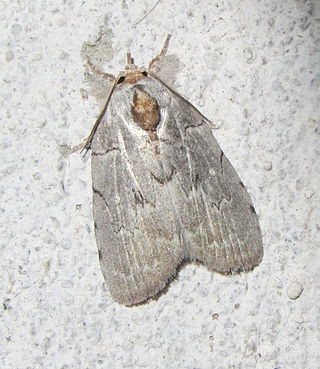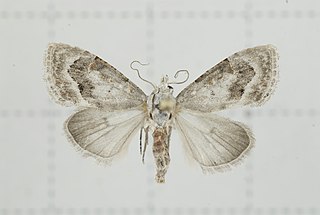
Asota caricae, the tropical tiger moth, is a species of noctuoid moth in the family Erebidae. It is found from the Indo-Australian tropics of India and Sri Lanka to Queensland and Vanuatu.

Argina astrea, the crotalaria podborer, is a moth of the family Erebidae. The species was first described by Dru Drury in 1773. It is found in eastern Africa, southern Asia of India, Sri Lanka, and Indo-Australia, including the Pacific Islands and Australia.

Nanaguna breviuscula, the pigeonpea pod borer, is a moth species of the family Nolidae. It is found from Sri Lanka and India east to Samoa. In Australia it is found in the Kimberleys in Western Australia, the northern part of the Northern Territory and from the Torres Strait Islands and Queensland to Sydney in New South Wales.

Altha subnotata is a moth of the family Limacodidae first described by Francis Walker in 1865. It is found in Sri Lanka, India and Nepal.
Aquis orbicularis is a moth of the family Nolidae first described by Francis Walker in 1858. It is found in the Indian subregion, Sri Lanka, Peninsular Malaysia, Papua New Guinea and Borneo.
Barasa acronyctoides is a moth of the family Nolidae first described by Francis Walker in 1862. It is found in Oriental region and east to Sulawesi and Fiji.
Giaura tortricoides is a moth of the family Nolidae first described by Francis Walker in 1865. It is found in Sri Lanka, Japan, Andaman Islands, Borneo, Sumatra, Flores, Sulawesi, New Guinea, Bismarck Islands and Australia.
Lophothripa vitea is a moth of the family Nolidae first described by Swinhoe in 1885. It is found in Indo-Australian tropics towards the Solomon Islands.

Maceda mansueta is a moth of the family Nolidae first described by Francis Walker in 1857. It is found in Japan, Sri Lanka, Borneo, India (Andamans), Malaysia, New Guinea, Fiji, Australia, Réunion and the Seychelles.

Maurilia iconica is a moth of the family Nolidae first described by Francis Walker in 1857. It is found in Indo-Australian tropics of Sri Lanka, Australia to the islands of Samoa, Rarotonga and New Caledonia.
Nycteola indicatana is a moth of the family Nolidae first described by Francis Walker in 1863. It is found in the Indian subregion, Sri Lanka, Singapore, Borneo, Java and the Solomon Islands.

Ptisciana seminivea is a moth of the family Nolidae first described by Frederic Moore in 1888. It is found in Oriental tropics of India, Sri Lanka, to Sundaland, the Philippines and Sulawesi.
Etanna basalis is a moth of the family Nolidae first described by Francis Walker in 1862. It is found in Borneo, Sri Lanka, Myanmar, Thailand, New Guinea, Australia, Vanuatu and Fiji.
Lasiolopha saturata is a moth of the family Nolidae first described by Francis Walker in 1865. It is found in Oriental tropics of India, Sri Lanka, Thailand, New Guinea and Australia.

Earias cupreoviridis, called the cupreous bollworm as a larva, is a moth of the family Nolidae. The species was first described by Francis Walker in 1862. It is found in African countries like Botswana, the Democratic Republic of the Congo, Eritrea, Ethiopia, the Gambia, Kenya, Nigeria, Sierra Leone, South Africa, Togo, Uganda, Zimbabwe to Asian countries like India, Sri Lanka, China, Japan, Korea, Philippines, Indonesia and Hong Kong.
Beara dichromella is a moth of the family Nolidae first described by Francis Walker in 1866. It is found in Sri Lanka, and India.

Carea angulata is a moth of the family Nolidae first described by Johan Christian Fabricius in 1793. It is found in India, Sri Lanka, China and Indonesia.

Xenochroa chlorostigma is a moth of the family Nolidae first described by George Hampson in 1893. It is found in India, Sri Lanka, Himalaya, Sundaland, Philippines and Sulawesi.
Labanda saturalis is a moth in the family Nolidae first described by Francis Walker in 1865. It is found in Indo-Australian tropics of India, Sri Lanka, and from New Guinea to the Solomon Islands.

Nola fasciata is a moth of the family Nolidae first described by Francis Walker in 1866. It is found in Indo-Australian tropics of India, Sri Lanka to Borneo, Taiwan, New Guinea and Australia.











